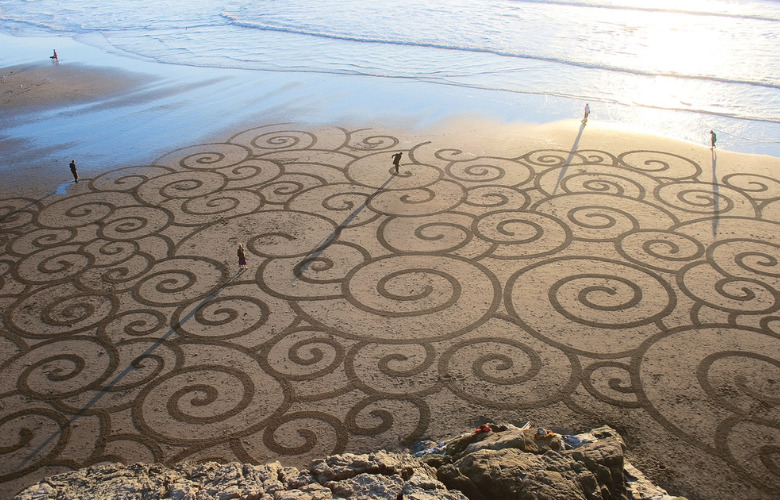
Land Art, also known as Earth Art, Environmental Art, or Earthworks, is an art movement that emerged in the 1960s and 1970s. It was established by a group of pioneering artists who investigated natural sites, alternative modes of artistic production, and ways to circumvent the commercial art system. The art form is largely a North American movement but nowadays can be found all over the world.
The Land Art movement was an outgrowth of Conceptualism and Minimalism.
It began in all earnestness in the 1960s when, especially western societies, saw the beginnings of an environmental movement. These developments and changes in mentality had a direct impact on the art scene of the time.
Artists longed to find ways to free art from the golden cage of traditions which hampered them from truly expressing themselves.
They longed to set their work free from art galleries and museums. Outside those traditional spaces, anything was possible. Art could all of a sudden be monumental. It could take any new shape and form.
The first Land Art artists were drawn to the humble everyday materials of Arte Povera and to revolutionary artistic thought leaders of the time, like German artist Joseph Beuys whose philosophy stated that performance and creativity are possible for anyone in any environment.
One of Joseph Beuys’s most famous statements was:
“Every human being is an artist, a freedom being, called to participate in transforming and reshaping the conditions, thinking and structures that shape and inform our lives.”
Thus, Land Art is usually made directly in the landscape by sculpting the land itself or by making structures in the landscape with natural materials.
What began with incorporating natural materials like dirt, rocks, and plants quickly grew into a process-based approach to artmaking in which the artist would make excursions into the surrounding environment to either collect objects or perform site-specific interventions.
Some artists used tools and even mechanical earth-moving equipment to make their earthworks. Whilst others made minimal and temporary interventions in the landscape.
Artists typically used photographs, films, and maps to document their Land Art and make these documentations available for exhibition in urban art spaces and galleries.
Some land artists also made Land art directly in the gallery by incorporating natural materials from the landscape into sculptures and installations.
However, even though land artists were still connected in some ways to the art world, they, at the same time, rejected the traditional ways of exhibiting art in secluded spaces.
By creating and showing their artworks mostly outside of these institutions, land artists made a clear statement that they did not agree anymore with the commodity status these venues conferred on art.
The artists also challenged the traditional definitions of art as something to be bought and sold for profit. More often than not, their art was accessible and visible for free.
The early Land Art of the 1960ies was reminiscent of the much older land works of our ancestors, Stonehenge, the Pyramids, Native American mounds, the Nazca Lines in Peru, the Carnac stones, and Native American burial grounds.
Often the artworks were stunning and evoked the spirituality of such archeological sites.
The American West was especially attractive for creating art within and with nature. The austere environments of the Great Basin and the Colorado Plateau, for example, offered an abundance of space and material far removed from the urban centers of the art world.
Robert Smithson, Nancy Holt, Walter de Maria, Michael Heizer, Ana Mendieta, Agnes Denes, Milton Becerra, Christo and Jeanne-Claude, Richard Long, and Andy Goldsworthy, to name only a few.
Nowadays, the creative practice of Land Art continues. Around the world, there are artists collaborating to continue in the same spirit, often using their art to point out the importance of ecological awareness and responsibility.
Two examples of Land Art happening right now on a grand and beautiful scale, are the Biennials Art Safiental in Switzerland and Andorra Land Art in Andorra.
The Art Story, Summary of Earth Art
Artland Magazine, Top 10 Land Art and Earthwork Pioneers
Art News, 15 Essential Works of Land Art, from Great Salt Lakes to Dusty Fields, to Lightning
Celebrating Nature and Cultural Heritage: Andorra Land Art
The Art Biennale ART SAFIENTAL in the Swiss Alps


Liam Klenk was born in Central Europe and has since lived on four continents. Liam has always been engaged in creative pursuits, ranging from photography and graphic design, to writing short stories and poetry, to working in theatre and shows. In 2016, Liam published his first book and memoir, 'Paralian'.
Read Full Profile© 2021 TheatreArtLife. All rights reserved.

Thank you so much for reading, but you have now reached your free article limit for this month.
Our contributors are currently writing more articles for you to enjoy.
To keep reading, all you have to do is become a subscriber and then you can read unlimited articles anytime.
Your investment will help us continue to ignite connections across the globe in live entertainment and build this community for industry professionals.